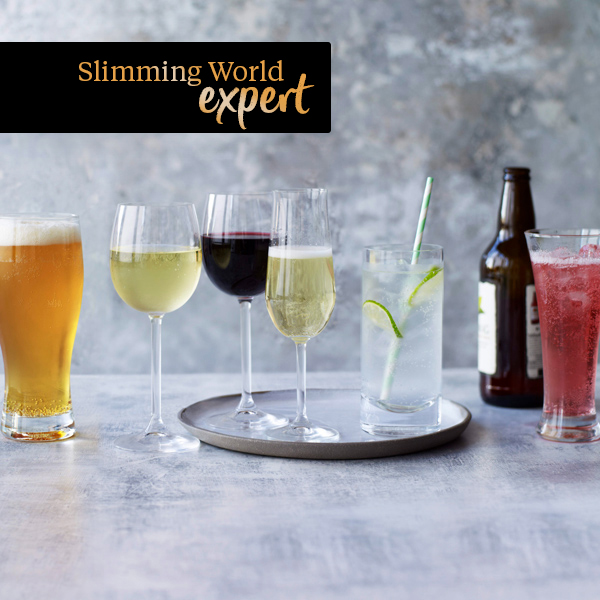Slimming World research shows that alcohol can have a major impact on weight loss**. While most of us know that alcohol contains ‘hidden calories’, which are often higher than we realise and don’t fill us up like the calories in food. What you might not have considered is your ‘tipping point’.
Reaching the ‘tipping point’
The tipping point is the point at which drinking alcohol tips us into drinking and eating far more than we ever intended – and it can impact hugely on our weight. In fact, our research revealed that it can lead us to consume, on average, an extra 6,300 calories in food and alcohol over the following two days. The study also found that half of those questioned reported cancelling physical activity they’d planned for the next day in favour of watching TV, staying in bed or spending time on social media.
Average tipping point for men = 4 pints of beer
Average tipping point for women = 2.5 glasses of wine
88% of Slimming World members surveyed said they’d learned new ways to make healthier food choices after drinking alcohol
MORE FOR MEMBERS: Slimming World members can easily check the Syn values of their alcoholic drinks using the handy online food search tool or the barcode scanner on the Slimming World app
Making simple swaps
There’s no reason to give up alcohol completely, unless that’s something you want to do. Here are some simple swaps and strategies to help you cut down, while still enjoying a tipple or two:
- Alternate alcoholic drinks with soft drinks or a glass of water.
- Make simple swaps such as switching from stout to a low-calorie beer.
- Measure out drinks, rather than guessing – this can be a real eye-opener!
- Make short spirits last longer by adding more mixer – or opt for a white wine spritzer.
- Swap to small wine glasses – some large glasses hold up to a third of a bottle!
- Decide in advance how many drinks you’ll have. You could ask a supportive partner or friend to help you stick to this.
- Try to have at least two alcohol-free days a week.
- Avoid drinking on an empty stomach – eating a healthy, filling meal beforehand is a good idea.
86% of the members we surveyed for our ‘tipping point’ study said that they still enjoyed alcohol in moderation and continued to lose weight steadily
Slimming World member Ian found his healthy booze balance and lost 10st. He says:
“I started gaining weight from the age of 20 – all I cared about was work, going out drinking, and eating junk food. At the time, I wouldn’t have said I drank in excess, but I also didn’t consider the calories I was having when downing pints of lager or cider. Although I’d never touch a full-fat cola, thinking it was packed with sugar, I’d happily down a pint of lager without even thinking about it. I’d go on to eat more than I intended, too, often grabbing a takeaway pizza on my way home from the pub. In February 2019, I weighed over 22st. It was time to make a change.”
MORE ON THE BLOG: Read Ian’s story here
92% of members surveyed said that, since joining Slimming World, they’ve discovered simple strategies to change their drinking habits without feeling they’re missing out
MORE FOR MEMBERS: Read more about the tipping point and identify your personal danger zones
The NHS states long-term regular drinking (over 10-20 years) can lead to increases in certain cancers, heart disease, liver disease and stroke, among other illnesses. Government health guidance says that we should limit consumption to no more than 14 units a week – that’s around six pints of beer, six medium glasses of wine or 14 measures of spirits – spread over three or more days to help keep the health risks from alcohol to a low level. Pregnant or breastfeeding women are advised to avoid alcohol completely. Find more info on calculating units of alcohol here.
** The ‘tipping point’ study was conducted by YouGov and Slimming World in 2013. It polled a representative sample of 2042 UK adults and included questions on drinking habits and behavioural impacts. You can read more here.


